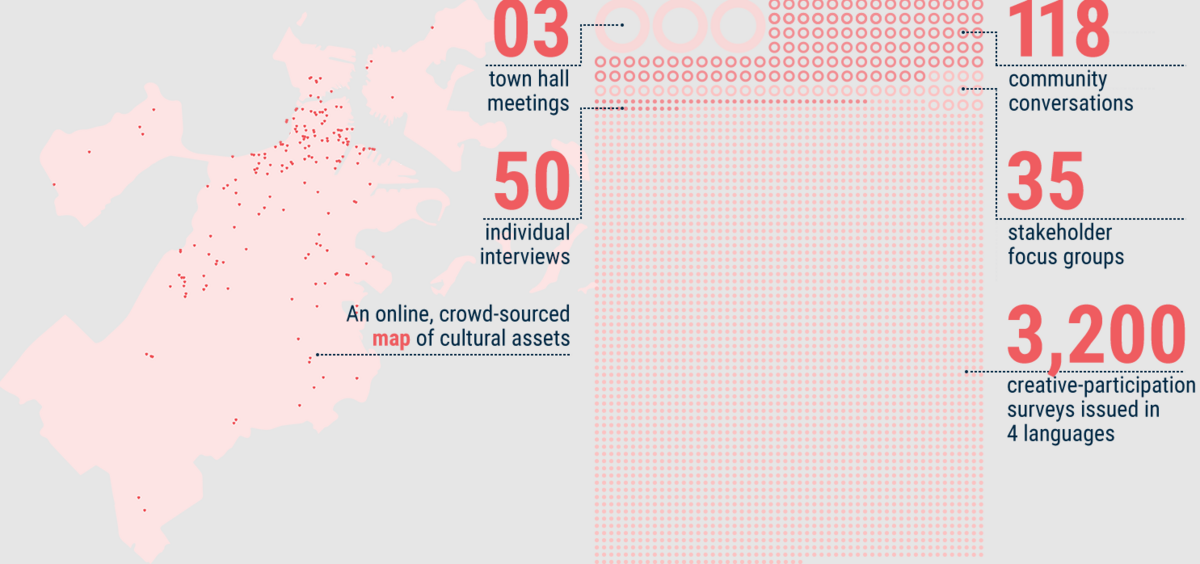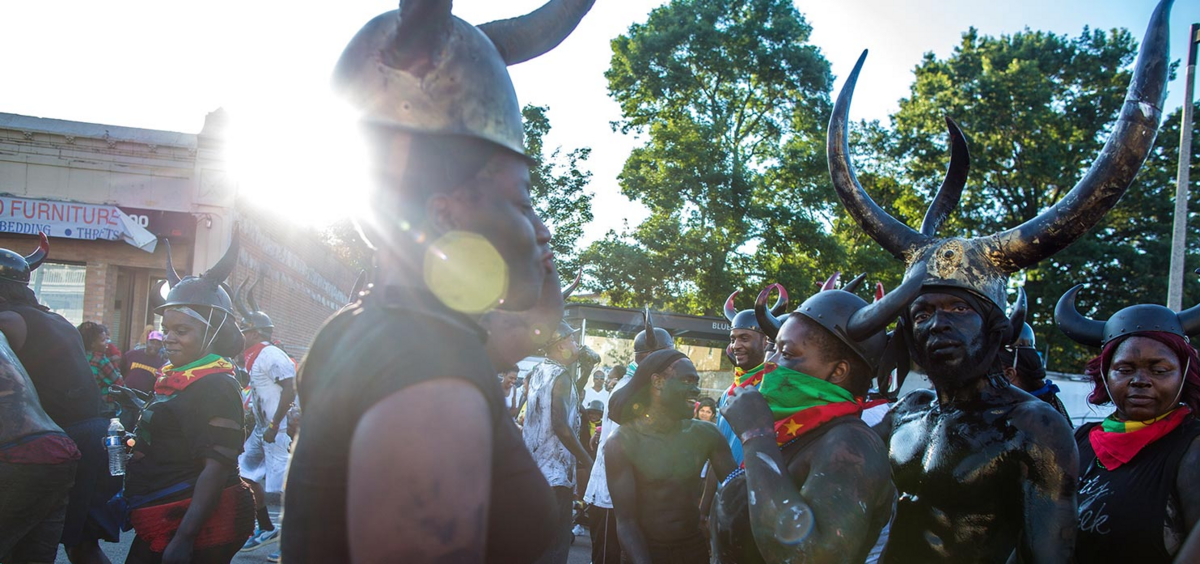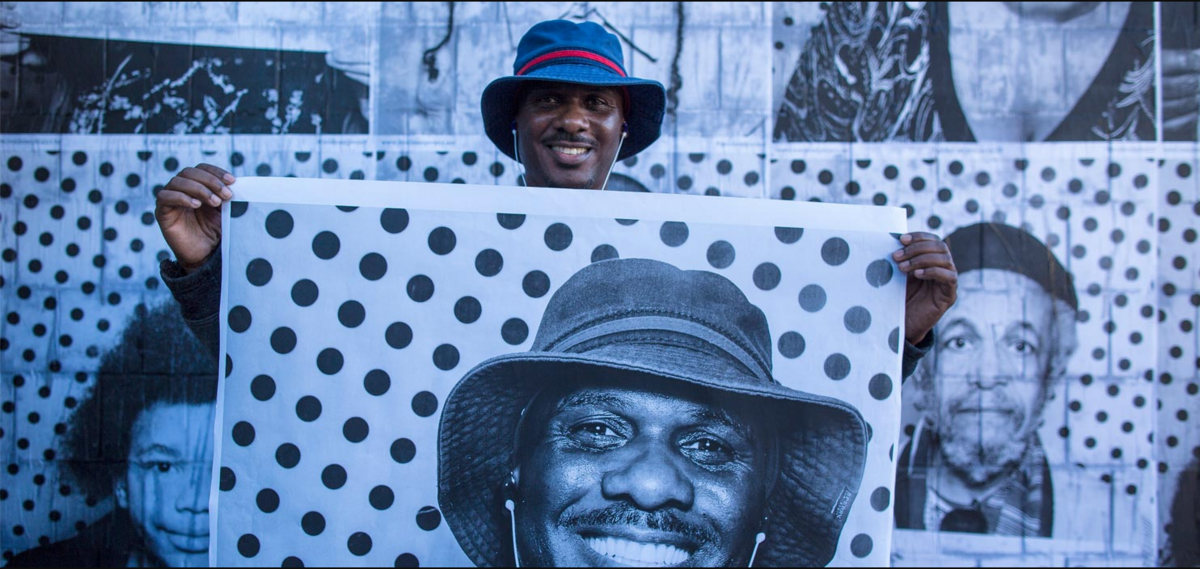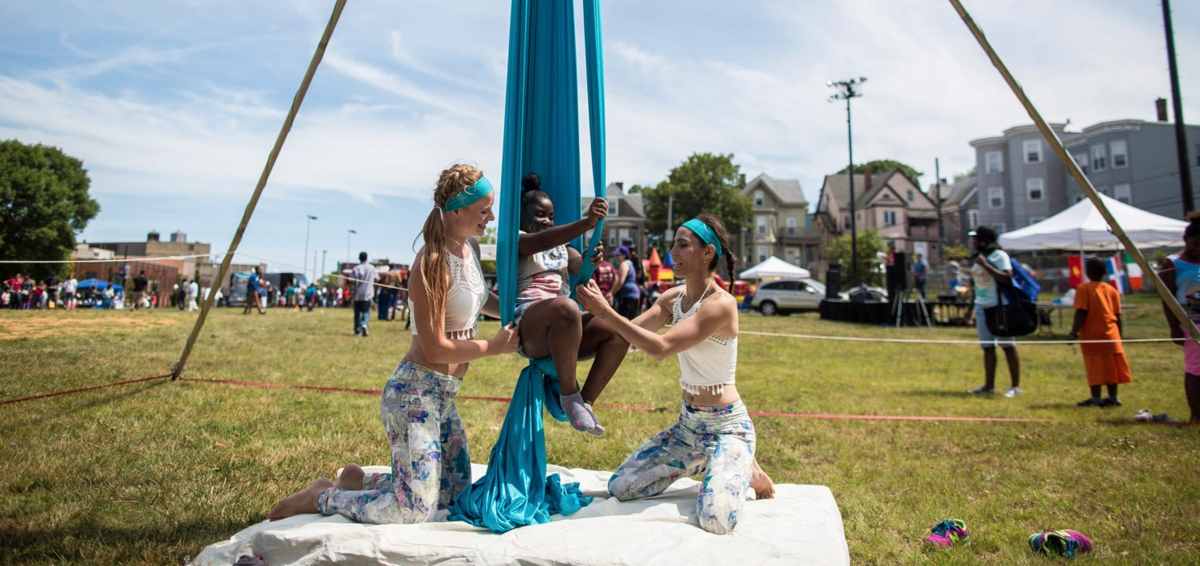Boston Creates: Community engagement and research findings
The Boston Creates planning process had three goals.
The first was to expand and deepen the public conversation — already underway when the Mayor launched the planning process in April 2015 — about arts and culture in Boston. The second was to break down barriers, foster collaboration, empower artists and grassroots cultural leaders, and mobilize the cultural community for collective action. The process itself was designed to stimulate the kind of collaboration that will be needed to realize the vision articulated in the plan. The third goal was to create a strategic framework for strengthening the city’s arts and cultural life. This framework is intended to highlight needs, articulate opportunities, and identify ways of deploying both existing and new resources to make Boston’s arts and culture sector stronger, more sustainable, more diverse, and more widely accessible.
The cultural plan articulates a common vision for arts and culture and gives voice to Bostonians’ aspirations as well as presents ideas about how to realize them. The planning process was rooted in shared values:
- openness and transparency
- inclusiveness
- creativity
- collaboration
- a steadfast commitment to learning
The community speaks
Boston Creates undertook an extensive community engagement process that opened with a town hall meeting on June 2, 2015 and ended on October 15, 2015 with the close of a citywide online survey.
The mixed-method research process included:
- 3 town hall meetings;
- 118 community conversations;
- 35 stakeholder focus groups and 50 one-on-one interviews;
- a creative engagement participation survey in 4 languages;
- and an online, crowd-sourced map of cultural assets.
To ensure the widest possible range of responses, the engagement process included advertising in culturally specific news outlets for the general public in addition to traditional outlets for arts and culture sector-specific news and events. We designed the process to be accessible and welcoming to a broad cross-section of residents and visitors, sector participants, and stakeholders, including:
- arts and culture audiences and participants
- artists, creators, makers, performers
- producers, presenters, programmers, teachers, architects, administrators, designers, media makers, and other representatives of the nonprofit and for-profit arts sectors
- arts and culture supporters, donors, trustees, foundations, corporate givers
- youth and young adults
- young professionals, parents, and seniors
- representatives of allied sectors such as tourism, higher education, health care, regional planning, public safety, health and human services, real estate development, finance
- representatives of City government
To identify individuals from whom to seek input, Boston Creates used a “Creative Capital” framework. Developed specifically for Boston and based on research attempting to measure the “cultural vitality of cities,” the Creative Capital framework suggests that a culturally vibrant city requires:
- Creatively engaged youth, families, individuals, and communities
- A strong pool of artists and creative entrepreneurs
- An active marketplace for arts, culture, and creativity
- Sustainable arts and culture institutions and venues
- Supportive civic/municipal policies and goals
- Active use of the arts and creative enterprises to animate and problem-solve in all aspects of public life
Through its various outreach and engagement methods, Boston Creates involved more than 5,000 residents and visitors to Boston, thereby gaining a broad and detailed perspective on the city’s arts and culture sector.
Powered by volunteers
Volunteer-led community teams were at the heart of the community engagement effort. These teams were responsible for connecting neighborhoods and communities to the process, leading community conversations, and encouraging participation in Boston Creates. They gathered ideas for the plan, empowered neighborhood cultural leaders, and fostered cohesion among local cultural organizations and artists. The team chairs are trusted leaders in their respective communities who helped Boston Creates hear from a broad range of voices. The City recruited additional team members through an open application process. A youth team, composed of volunteer high school students, led conversations with young residents of all the city’s neighborhoods.
The community teams reflected the city’s diversity in terms of culture, neighborhood, language, and age, and included many artists and creative workers. The teams had high levels of participation and energy and a strong sense of camaraderie. Each team collected information from its community in slightly different ways and created its own unique story about the community’s experience with Boston’s arts and cultural life. Participants also built relationships, formed collaborations, and generated a shared awareness of the possibilities for cultural development that is reverberating throughout Boston. It will be important to build on this work in order to move the plan forward.
Creative Engagement
Department of Play (DoP)—a Boston-based collective that makes temporary play zones in public areas—assisted the community engagement process. DoP creates opportunities for city residents to step out of their everyday lives and have collective experiences of play in public spaces, taking a break to reflect on their relationship with the city and with one another. We invited DoP to serve as a creative resource for the Boston Creates team and to engage a broad cross-section of the public.
Using the Boston Creates logo, DoP designed jumbo, interlinking foam blocks for building structures. They used these blocks at public festivals and at youth meetings, inviting people to build their visions for the future of Boston’s arts and culture. DoP also worked with the Mayor’s Office of New Urban Mechanics to add an “I imagine something here” tab and icon to the asset map on Boston Creates’ website. Using text and/or images, people could pin their ideas for art amenities to specific locations on the map. DoP contributed to the creative engagement of Boston residents during the planning process and facilitated the work of the Boston Creates artistethnographers.
Artist-ethnographers
To extend and enrich the community engagement process, Boston Creates employed three Boston ethnographers: two artist-ethnographers, Heather Kapplow and Shaw Pong Liu, and a photographer-ethnographer, Leonardo March. Selected from a pool of thirty-two applicants, these artists invited Bostonians to connect with one another—sometimes in surprising ways—and, through shared experiences with art, to reflect about their city and the future of arts and culture here.
Heather Kapplow, a self-trained conceptual artist, creates engagement experiences designed to create unexpected intimacies. “In addition to being an artist,” she writes, “I’ve been documenting public debate/discussion and art/performance, and/or facilitating it in various ways, for a living and as a volunteer for most of my adult life.” In her culminating project for Boston Creates, Driving Culture, Heather created what she describes as “a design for a city vehicle using the actual handwritten desires expressed by citizens of greater Boston at Boston Creates meetings.” Her objective was to enable Bostonians’ “exact words, and the nuances of people’s individual voices” to be heard.
Shaw Pong Liu, a classically trained violinist and composer, and a teaching artist, connects people of diverse ages, backgrounds, cultures, disciplines, and ideas through the transformative power of music, stories, and interactive art-making in what she calls “genre-defying performances.” For Boston Creates, she created What Artists Knead, a series of bread-making parties in five Boston neighborhoods at which artists baked bread and discussed their ideas for Boston’s creative future. In a current project as one of three artists-in-residence for the City of Boston for 2016, Shaw Pong is exploring “how music can support healing and dialogue around challenging topics of gun violence, race, and law enforcement practices.”
Leonardo March, whose job was to document in photographs the listening phase of Boston Creates and make a photographic portrait of Boston’s creative life, became interested in the people behind the landscape he photographed, including what they do in their free time and how they invest their creative energy. He sees his work for Boston Creates as “expanding the image of the city in the minds of the people who live here, incorporating images of ethnic festivals, religious festivals, various entertaining events, and political protests.”
Findings: Barriers to Boston’s creative potential
Throughout the community engagement process, a number of needs, concerns, and challenges around infrastructure, equity and inclusion, and/or leadership and resources rose to the top as priorities. Issues that surfaced most often—most, though not all, mentioned above—include:
- Fragmentation in the Arts and Culture Sector: Bostonians experience the city’s arts and culture sector as vibrant but fragmented. Participants in the engagement process seek opportunities for increased partnership with City government, with other sectors, and within the arts and culture sector to work collaboratively on creative ways to address the needs of the sector.
- Barriers to Attendance and Engagement: Barriers to attending cultural events are complex and differ according to neighborhood and income level. The obstacles cited most commonly by households with incomes under $25,000 included transportation challenges, lack of social support (e.g., no one to go with), and lack of time due to work obligations. Respondents living in households with incomes over $100,000 also identified work and family commitments as barriers to attendance at cultural events. The most prevalent barrier to participation in creative activities is work commitments, cited by 43 percent of all respondents, followed by affordability (i.e., couldn’t afford materials or instruction), named by 28 percent of respondents overall but predominantly by those with household incomes under $25,000.
- Equity and Opportunity: Participants in the engagement process seek equitable recognition and respect for diverse cultural heritages and artistic practices in Boston. They see a number of complex issues standing in the way, particularly racism and widening income disparities. People spoke of the need for several specific improvements in equity and opportunity within the arts and culture sector, including: more funding opportunities for small organizations and community-based activities; more recognition and valuing of neighborhood cultural assets; and greater exposure to artwork representative of diverse cultures.
- Spaces and Facilities: The engagement process revealed a deep and widespread need for affordable cultural spaces for people to gather, create, collaborate, and participate in the arts. Participants would like to see the use of more spaces for the arts beyond the downtown core, including libraries, the Boston Centers for Youth and Families, historic buildings, and public spaces. Within the nonprofit sector, access to facilities that are affordable and appropriate for performance and the visual arts disciplines emerged as a common theme, especially from small and mid-sized organizations. Large arts and culture organizations described challenges related to the cost of maintaining physical spaces and facilities. Performing arts organizations are experiencing a number of acute difficulties involving space.
- Youth Arts and Education: Bostonians called for more comprehensive arts education programs, more equitable access to arts education, and increased opportunities for participation both in and out of school. Specifically, they expressed a desire to support the efforts of the Boston Public Schools to expand its arts education offerings. Boston youth and arts service providers voiced a need for more youth leadership opportunities across arts education programs and activities. Boston youth seek opportunities to create, socialize around arts activities, and enliven public spaces in innovative ways.
- Access to Information: Various groups expressed a desire for a more robust and accessible information network, for a variety of reasons. Boston residents and visitors described a need for better ways to learn about arts and culture offerings. Boston artists and the nonprofit arts sector seek an effective platform for citywide and regional marketing to augment their individual and collective efforts. Boston’s emergent artists and individuals working with youth stated a need for a one-stop source of information for youth-focused arts activities and opportunities.
- New, Sustainable Resources: Participants identified a need for greater investment in Boston’s arts and culture sector through increased public funding as well as private, corporate, and foundation support. They expressed a nearly unanimous hope that City government can serve as a catalyst for public and private resources in support of arts and culture. Participants across groups also recognized that systemic change in how arts and culture are funded in Boston will require a collective and concerted effort.






